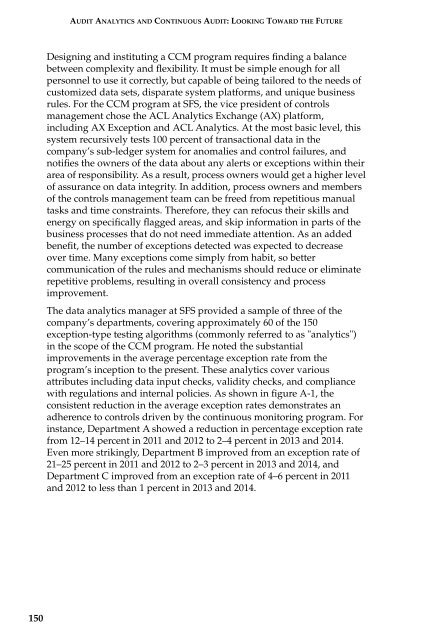AUDIT ANALYTICS AUDIT
1JWn3ix
1JWn3ix
You also want an ePaper? Increase the reach of your titles
YUMPU automatically turns print PDFs into web optimized ePapers that Google loves.
<strong>AUDIT</strong> <strong>ANALYTICS</strong> AND CONTINUOUS <strong>AUDIT</strong>:LOOKING TOWARD THE FUTURE<br />
Designing and instituting a CCM program requires finding a balance<br />
between complexity and flexibility. It must be simple enough for all<br />
personnel to use it correctly, but capable of being tailored to the needs of<br />
customized data sets, disparate system platforms, and unique business<br />
rules. For the CCM program at SFS, the vice president of controls<br />
management chose the ACL Analytics Exchange (AX) platform,<br />
including AX Exception and ACL Analytics. At the most basic level, this<br />
system recursively tests 100 percent of transactional data in the<br />
company’s sub-ledger system for anomalies and control failures, and<br />
notifies the owners of the data about any alerts or exceptions within their<br />
area of responsibility. As a result, process owners would get a higher level<br />
of assurance on data integrity. In addition, process owners and members<br />
of the controls management team can be freed from repetitious manual<br />
tasks and time constraints. Therefore, they can refocus their skills and<br />
energy on specifically flagged areas, and skip information in parts of the<br />
business processes that do not need immediate attention. As an added<br />
benefit, the number of exceptions detected was expected to decrease<br />
over time. Many exceptions come simply from habit, so better<br />
communication of the rules and mechanisms should reduce or eliminate<br />
repetitive problems, resulting in overall consistency and process<br />
improvement.<br />
The data analytics manager at SFS provided a sample of three of the<br />
company’s departments, covering approximately 60 of the 150<br />
exception-type testing algorithms (commonly referred to as "analytics")<br />
in the scope of the CCM program. He noted the substantial<br />
improvements in the average percentage exception rate from the<br />
program’s inception to the present. These analytics cover various<br />
attributes including data input checks, validity checks, and compliance<br />
with regulations and internal policies. As shown in figure A-1, the<br />
consistent reduction in the average exception rates demonstrates an<br />
adherence to controls driven by the continuous monitoring program. For<br />
instance, Department A showed a reduction in percentage exception rate<br />
from 12–14 percent in 2011 and 2012 to 2–4 percent in 2013 and 2014.<br />
Even more strikingly, Department B improved from an exception rate of<br />
21–25 percent in 2011 and 2012 to 2–3 percent in 2013 and 2014, and<br />
Department C improved from an exception rate of 4–6 percent in 2011<br />
and 2012 to less than 1 percent in 2013 and 2014.<br />
150


